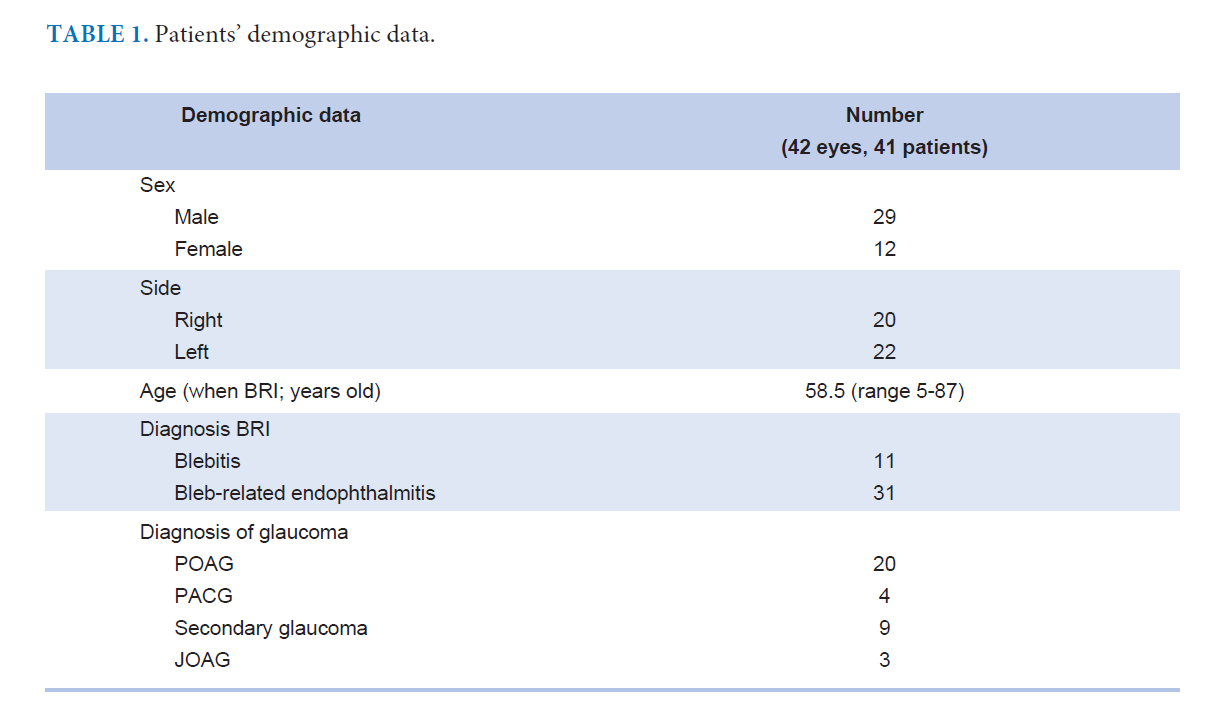Clinical Characteristics and Outcome of Bleb-Related Infection in Glaucoma Patients
DOI:
https://doi.org/10.33192/Smj.2022.66Keywords:
Bleb infection, blebitis, bleb-related endophthalmitis, predisposing behavior, patient educationAbstract
Objective: To study the clinical characteristics, causative organism, treatment, and clinical outcomes of bleb-related infection.
Materials and Methods: The medical charts of patients who were diagnosed with bleb-related infection, including blebitis and bleb-related endophthalmitis (BRE), from September 2001 to December 2019 at Siriraj Hospital were reviewed. The patients’ demographic data, clinical characteristics, microorganisms found, treatment, and clinical outcomes were explored.
Results: We found a total of 42 eyes from 41 patients had been diagnosed with blebitis (11 eyes) and BRE (31 eyes) over the 18-year study period. More than 80% of the patients had experienced pain and redness as the presenting symptoms. The most common bleb characteristic in BRE was purulent bleb (74.2%), while in blebitis it was bleb injection (45.5%). Bleb leakage was documented in 27.3% and 22.6% of patients with blebitis and BRE, respectively. Among the 41 patients, 10 had a history of minor trauma before the onset of infection, such as a rubbed eye, foreign body entering into the eye, water splashed into the eyes, or the eyes had been washed with soap. The yield of vitreous culture in bleb-related endophthalmitis was 48.3%. The most common microorganisms were Streptococcus spp., Enterococcus spp., and Haemophilus Influenzae. Generally, the treatment for blebitis at our institute is broad spectrum topical and systemic antibiotics, while intravitreal broad spectrum antibiotics are added to the treatment regimen for BRE patients. For BRE in our cohort, 11 eyes required vitrectomy and 7 eyes had undergone bleb excision. Treatment for blebitis tended to have a good visual outcome, with a stable visual prognosis for 9 out of the 11 eyes diagnosed with blebitis. However, most of the BRE eyes had a worsened visual outcome. Enterococcus spp. and Haemophilus Influenzae resulted in poor visual outcomes.
Conclusion: The clinical characteristics of bleb-related infection in our patients were pain and redness. One fourth of patients had a history of minor trauma to the eye. To prevent bleb-related infection, the importance of patient education after trabeculectomy should be highlighted. Patients with presenting symptoms and unwanted behavior that could result in bleb infection should be identified and receive treatment alongside education.
References
Petchyim S, Tantimala R, Prabhasawat P, Chonpimai P, Prukajorn M, Ruangvaravate N. Change in Corneal Endothelial Cell Density after Baerveldt Shunt Implantation in Glaucoma Patients. Siriraj Med J. 2021;73(4):252-8.
Brown RH, Yang LH, Walker SD, Lynch MG, Martinez LA, Wilson LA. Treatment of Bleb Infection After Glaucoma Surgery. Arch Ophthalmol. 1994;112(1):57-61.
Lehmann OJ, Bunce C, Matheson MM, Maurino V, Khaw PT, Wormald R, et al. Risk factors for development of posttrabeculectomy endophthalmitis. Br J Ophthalmol. 2000;84(12):1349.
Aekplakorn W, Stolk RP, Neal B, Suriyawongpaisal P, Chongsuvivatwong V, Cheepudomwit S, et al. The Prevalence and Management of Diabetes in Thai Adults. Diabetes Care. 2003;26(10):2758.
Mitchell P, Smith W, Chey T, Healey PR. Open-angle Glaucoma and Diabetes: The Blue Mountains Eye Study, Australia. Ophthalmology. 1997;104(4):712-8.
Greenfield DS, Suñer IJ, Miller MP, Kangas TA, Palmberg PF, Flynn HW, Jr. Endophthalmitis After Filtering Surgery With Mitomycin. Arch Ophthalmol. 1996;114(8):943-9.
Higginbotham EJ, Stevens RK, Musch DC, Karp KO, Lichter PR, B ergstrom TJ, et al. Bleb-related Endophthalmitis after Trabeculectomy with Mitomycin C. Ophthalmology. 1996;103(4):650-6.
Kangas TA, Greenfield DS, Flynn HW, Parrish II RK, Palmberg P. Delayed-onset endophthalmitis associated with conjunctival filtering blebs. Ophthalmology. 1997;104(5):746-52.
Luebke J, Neuburger M, Jordan JF, Wecker T, Boehringer D, Cakir B, et al. Bleb-related infections and long-term follow-up after trabeculectomy. Int Ophthalmol. 2019;39(3):571-7.
Yamamoto T, Sawada A, Mayama C, Araie M, Ohkubo S, Sugiyama K, et al. The 5-year incidence of bleb-related infection and its risk factors after filtering surgeries with adjunctive mitomycin C: collaborative bleb-related infection incidence and treatment study 2. Ophthalmology. 2014;121(5):1001-6.
Kim E-A, Law SK, Coleman AL, Nouri-Mahdavi K, Giaconi JA, Yu F, et al. Long-Term Bleb-Related Infections After Trabeculectomy: Incidence, Risk Factors, and Influence of Bleb Revision. Am J Ophthalmol. 2015;159(6):1082-91.
Song A, Scott IU, Flynn HW, Jr., Budenz DL. Delayed-onset bleb-associated endophthalmitis: clinical features and visual acuity outcomes. Ophthalmology. 2002;109(5):985-91.
Lehmann OJ, Bunce C, Matheson MM, Maurino V, Khaw PT, Wormald R, et al. Risk factors for development of posttrabeculectomy endophthalmitis. Br J Ophthalmol. 2000;84(12):1349-53.
Sharan S, Trope GE, Chipman M, Buys YM. Late-onset bleb infections: Prevalence and risk factors. Can J Ophthalmol. 2009;44(3):279-83.
Busbee BG, Recchia FM, Kaiser R, Nagra P, Rosenblatt B, Pearlman RB. Bleb-associated endophthalmitis: clinical characteristics and visual outcomes. Ophthalmology. 2004;111(8):1495-503; discussion 503.
Yamamoto T, Kuwayama Y, Kano K, Sawada A, Shoji N. Clinical features of bleb-related infection: a 5-year survey in Japan. Acta Ophthalmol. 2013;91(7):619-24.

Published
How to Cite
Issue
Section
License

This work is licensed under a Creative Commons Attribution-NonCommercial-NoDerivatives 4.0 International License.
Authors who publish with this journal agree to the following conditions:
Copyright Transfer
In submitting a manuscript, the authors acknowledge that the work will become the copyrighted property of Siriraj Medical Journal upon publication.
License
Articles are licensed under a Creative Commons Attribution-NonCommercial-NoDerivatives 4.0 International License (CC BY-NC-ND 4.0). This license allows for the sharing of the work for non-commercial purposes with proper attribution to the authors and the journal. However, it does not permit modifications or the creation of derivative works.
Sharing and Access
Authors are encouraged to share their article on their personal or institutional websites and through other non-commercial platforms. Doing so can increase readership and citations.














